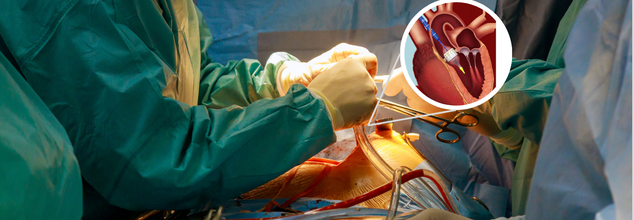- Health Conditions A-Z
- Health & Wellness
- Nutrition
- Fitness
- Health News
- Ayurveda
- Videos
- Medicine A-Z
- Parenting
Frail And Breathless At 94, Woman Overcomes Severe Breathlessness After Life-Saving Heart Procedure

As a cardiologist, I've had many cases, but few that impacted me as powerfully as that of Mrs. Bhanbai Gala, a 94-year-old woman from Mumbai in India, who survived with determination to attend her great-grandson's wedding after accepting to go under the revolutionary Transcatheter Aortic Valve Replacement (TAVR) surgery.
Mrs. Gala, thin and only 36 kg in weight, had been having severe aortic stenosis, which made her aortic valve narrow and limited blood passage. She complained of chronic chest heaviness and shortness of breath, precluding her from walking more than a few meters. Due to her bypass operation history in 2010 and her poor state, she was highly susceptible to open-heart surgery. Her family, particularly her granddaughter, Dr. Mita Gala—a general practitioner—was much concerned with her health condition.
Mrs. Gala did have a wish though: she desired to attend the wedding of her great-grandson. This tender aspiration pushed her family towards attempting medical remedies for her illness even with the attendant risks.
Following careful consideration, I advised TAVR, a minimally invasive procedure to replace the stenosed aortic valve without open-heart surgery. Due to her advanced age, history of cardiac disease, and petite stature, the procedure was fraught with risk. Nevertheless, with careful planning and precise execution, we believed that we could provide her with a new quality of life.
The operation was done under local anesthetic. Using a catheter placed through the femoral artery, we replaced her failing aortic valve within an hour. In spite of her complicated anatomy and pre-existing trifascicular AV block, the new valve worked immediately, enabling her to breathe more comfortably during the night.
Within 48 hours, Mrs. Gala was discharged from the hospital. At her one-month follow-up, she was doing amazingly well—she was walking comfortably, going about her household activities, and even making her favorite dessert, Khajur Pak. Her turnaround was nothing short of inspiring.
Her family, initially hesitant about the procedure, was flooded with joy. Dr. Mita Gala, who too had her reservations as a doctor, was extremely thankful. "As a physician, I was unsure of the safety of TAVR for my grandmother, but Dr. Rao's knowledge and continuous guidance put our minds at rest," she stated. "Watching her experience the wedding traditions with such zest was a blessing indeed."
Mrs. Gala's story is a testament to the remarkable progress in interventional cardiology. TAVR has been a game-saver for patients with severe aortic stenosis, providing a safe and effective option, even for high-risk procedures. With each passing year, our experience with the procedure has enabled us to customize therapies to fit complicated anatomical and physiologic states, providing the optimal results.
Though long considered for patients who are not candidates for open-heart surgery, TAVR is increasingly being offered to younger, low-risk patients in their 60s if the valve can be replaced through the femoral artery. The success of these cases adds to the increased use of the procedure globally.
Since it was first applied in India in 2011, the TAVR procedure has been on the rise. With an estimated prevalence of 7.3% for isolated aortic stenosis alone, it's estimated that close to 300,000 individuals in India may be eligible for TAVR. The potential to deliver a life-enhancing therapy to an elderly patient such as Mrs. Gala is a reflection of the advancement of cardiology and the life-altering power of medical innovation.
Working Out For 10 Minutes May Decrease Your Risk Of Colorectal Cancer, Study Proves

Credit: Canva
Performing short and intense exercises that last for about 10 minutes may significantly reduce the risk of colorectal cancer, a British study shows.
Researchers at Newcastle University have found that completing brief workouts increases the concentration of several small molecules in the blood that have previously been linked to reducing inflammation, improving blood vessel function and metabolism.
The findings, which were published in the International Journal of Cancer, also noted that even short bouts of exercise can influence the activity of genes that govern tumor growth and fight against cancer.
Dr Sam Orange, Senior Lecturer in Clinical Exercise Physiology at Newcastle University and lead study author, said of the results, "What’s remarkable is that exercise doesn’t just benefit healthy tissues, it sends powerful signals through the bloodstream that can directly influence thousands of genes in cancer cells.
“It’s an exciting insight because it opens the door to find ways that mimic or augment the biological effects of exercise, potentially improving cancer treatment and, crucially, patient outcomes.
“In the future, these insights could lead to new therapies that imitate the beneficial effects of exercise on how cells repair damaged DNA and use fuel for energy.”
How Does It Work?
The study involved 30 participants, both male and female between the ages of 50–78. All of the participants were overweight or obese (a risk factor of cancer) but otherwise healthy.Researchers had asked each volunteer to complete a short, intense cycling test that lasted about 10 minutes and collected each of their blood samples which were then meticulously analyzed.
After studying about 249 proteins, the experts found nearly 13 protein had increased in their blood flow after the short exercise including interleukin-6 (IL-6), which helps repair the DNA of damaged cells.
When these exercise-induced proteins were applied to colorectal or bowel cancer cells by the scientists in a lab, they discovered that these new proteins could alter the activity of over 1,300 genes, particularly those who were responsible for DNA repair, energy production and cancer cell growth.
As a result, they concluded that performing even small exercises can activate a set of genes in the body's cells that can support efficient use of oxygen and promote energy metabolism. Additionally, the British researchers also discovered that the cell genes which have been previously associated with rapid cell growth were switched off after working out, suggesting that this might aid in controlling cancerous growths in the body.
What Is Colorectal Cancer?
Colorectal or bowel cancer is a common cancer that forms in the tissues of the colon (large intestine) or rectum, often starting as non-cancerous growths called polyps that turn cancerous over time.
Despite being treatable and preventable, colorectal cancer is currently the second leading cause of cancer-related deaths worldwide. Over 70,000 new cases of colorectal cancer occur annually in India, making it the fourth most common cancer in the country.
Typical symptoms usually include :
- Blood in or on the stool
- Changes in bowel habits (diarrhea, constipation, narrower stools)
- Abdominal discomfort, cramps, gas, or pain
- Feeling that your bowel doesn't empty completely
- Weakness, fatigue, or unexplained weight loss
Are You Taking Clonazepam? NHS Issues Urgent Safety Advice

Credits: Canva
The NHS has released updated guidance for people who are currently taking clonazepam, a commonly prescribed medicine that belongs to the benzodiazepine group. According to the health service, clonazepam is often used to control seizures or fits linked to epilepsy, ease involuntary muscle spasms, and help manage panic disorders. It is also prescribed in some cases for people with restless legs syndrome (RLS). NHS Inform notes that “around 1 in 10 people experience restless legs syndrome at some stage in their life.”
Explaining how the drug works, the NHS says it increases levels of gamma-aminobutyric acid (GABA), a chemical in the brain that has a calming effect. By boosting GABA, clonazepam can reduce anxiety, prevent seizures or fits, and relax tight or overactive muscles.
Who Can Take Clonazepam?
Clonazepam is only available on prescription and comes as tablets or a liquid. Most adults aged 18 and over can take either form. In certain cases, children as young as one month old may be prescribed clonazepam to treat epilepsy, as per NHS.
That said, there are situations where extra caution is needed. People who are due to have surgery or dental treatment, those who are pregnant, trying to conceive, or who have sleep-related conditions may be advised to stop taking the medicine. However, these are not the only groups the NHS says should be careful.
Clonazepam is not suitable for everyone. Before starting treatment, patients are advised to tell their doctor if they:
- have ever had an allergic reaction to clonazepam or any other medicine
- have myasthenia gravis, a condition that causes muscle weakness
- have sleep apnoea, which affects breathing during sleep
- have lung, liver, or kidney problems
- have spinal or cerebellar ataxia, which can cause shakiness, poor balance, and slurred speech
- have had problems with alcohol or drug use in the past
- have recently experienced bereavement, depression, or thoughts of self-harm or suicide
- have been diagnosed with a personality disorder
- are trying to get pregnant, are already pregnant, or are breastfeeding
- are due to have a general anaesthetic for an operation or dental procedure
What Are The Side Effects Of Clonazepam?
Like many medicines, clonazepam can cause side effects. Common effects, which affect more than 1 in 100 people, include disturbed sleep such as vivid dreams, feeling sleepy during the day, light-headedness, dizziness, unsteadiness, and muscle weakness.
When it comes to long-term use, the NHS warns that clonazepam can lead to withdrawal symptoms if taken for a prolonged period. Because of this risk, people who have been prescribed the drug for more than four weeks may have their dose reduced slowly when stopping treatment, rather than stopping suddenly.
The NHS also stresses that this is not a complete list of side effects. Patients are advised to read the information leaflet that comes with their medicine for full details.
Clonazepam: Serious Side Effects To Watch Out For
Although uncommon, some people may experience serious side effects while taking clonazepam. The NHS advises contacting a doctor or calling 111 immediately if you notice:
- yellowing of the whites of the eyes or skin, which may be less noticeable on darker skin tones, as this could point to liver problems
- seeing or hearing things that are not there, or believing things that are untrue
- problems with coordination or controlling movements
- swollen ankles, a fast heartbeat, coughing, and extreme tiredness, which could be signs of heart issues
- easy bruising, fatigue, nosebleeds, and breathlessness, which may indicate blood disorders
- changes in mood, such as talking more than usual, feeling unusually excited, restless, irritable, or aggressive, which are more likely in children or adults over 65
- Anyone experiencing memory problems, such as difficulty remembering things or amnesia, is advised to book an appointment with their doctor.
In rare cases, clonazepam can trigger a serious allergic reaction known as anaphylaxis.
Disclaimer: This article is for informational purposes only and is not intended as a substitute for professional medical advice, diagnosis, or treatment. Always consult a qualified doctor, pharmacist, or healthcare provider before starting, stopping, or changing the dosage of any medication.
Delhi Air Pollution Could Be Carrying Antibiotic-Resistant Superbugs, Study Suggests

Credits: AI Generated
Every winter, people in Delhi prepare themselves for stinging eyes, tight chests and coughs that refuse to go away as thick smog blankets the city. Now, fresh research from Jawaharlal Nehru University (JNU) suggests there is another hidden danger in the polluted air. According to the study, Delhi’s winter smog may also be carrying antibiotic-resistant bacteria, adding to health worries in one of the most polluted cities on the planet.
The research, titled Distribution and antibiotic resistance patterns of airborne staphylococci in urban environments of Delhi, India, was published in Nature – Scientific Reports. It found disturbingly high levels of antibiotic-resistant “superbugs” in both indoor and outdoor air across the city, particularly in winter when pollution levels spike. The findings point to polluted air acting as a possible vehicle for antimicrobial resistance (AMR), which experts already consider one of the gravest global health threats.
Antibiotic-Resistant Superbugs In Delhi Air Polluton: What Did The Study Investigate?
As per Indian Express, to understand what people might be breathing in, the researchers collected air samples from a range of everyday locations across Delhi, such as:
- Crowded market areas
- Urban slum neighbourhoods
- Residential apartments
- A sewage treatment plant located within the JNU campus
Both indoor and outdoor air samples were taken during summer, monsoon and winter to track how bacterial levels and resistance patterns shifted with the seasons.
Across every setting, airborne bacteria levels were far above the World Health Organization’s recommended safe limit for microbial exposure. In some winter samples, bacterial counts exceeded 16,000 colony-forming units per cubic metre, which is more than 16 times higher than the WHO guideline.
What raised even greater concern was the type of bacteria detected. Many belonged to the Staphylococcus group, which includes strains linked to skin infections, pneumonia, bloodstream infections and illnesses commonly acquired in hospitals.
According to the researchers, a large share of the airborne bacteria were identified as methicillin-resistant staphylococci (MRS), meaning they do not respond to commonly prescribed antibiotics. Among these:
- 73 per cent were multidrug-resistant, showing resistance to several classes of antibiotics
- Many were resistant to macrolides, beta-lactams, trimethoprim, gentamicin and other commonly used drugs
- Genetic analysis confirmed the presence of antibiotic resistance genes (ARGs)
Notably, 14 out of 36 multidrug-resistant samples carried the mecA gene, a well-known marker that makes bacteria resistant to methicillin and related antibiotics.
Why Is Winter Smog Linked To Drug-Resistant Bacteria?
The study showed that levels of airborne drug-resistant bacteria were highest in winter, while monsoon rains led to a sharp drop in outdoor contamination.
Researchers point to a few likely reasons:
- Poor air movement in winter traps pollutants and microbes near ground level
- High levels of particulate matter may give bacteria surfaces to cling to and spread
- Cooler temperatures and lower humidity allow bacteria to survive longer in the air
On the other hand, rainfall during the monsoon appears to clear bioaerosols from the air, reducing bacterial concentrations outdoors.
Who Is Most At Risk From Airborne Superbugs?
Many healthy people may breathe in these bacteria without becoming sick. However, the risk is much higher for:
- People with weakened immune systems
- Those living with chronic lung conditions
- Individuals with open wounds
- Older adults and young children
The researchers note that inhaling drug-resistant bacteria does not automatically lead to infection. Still, it raises the risk of infections that are harder to treat, especially if the bacteria manage to enter vulnerable parts of the body.
© 2024 Bennett, Coleman & Company Limited

